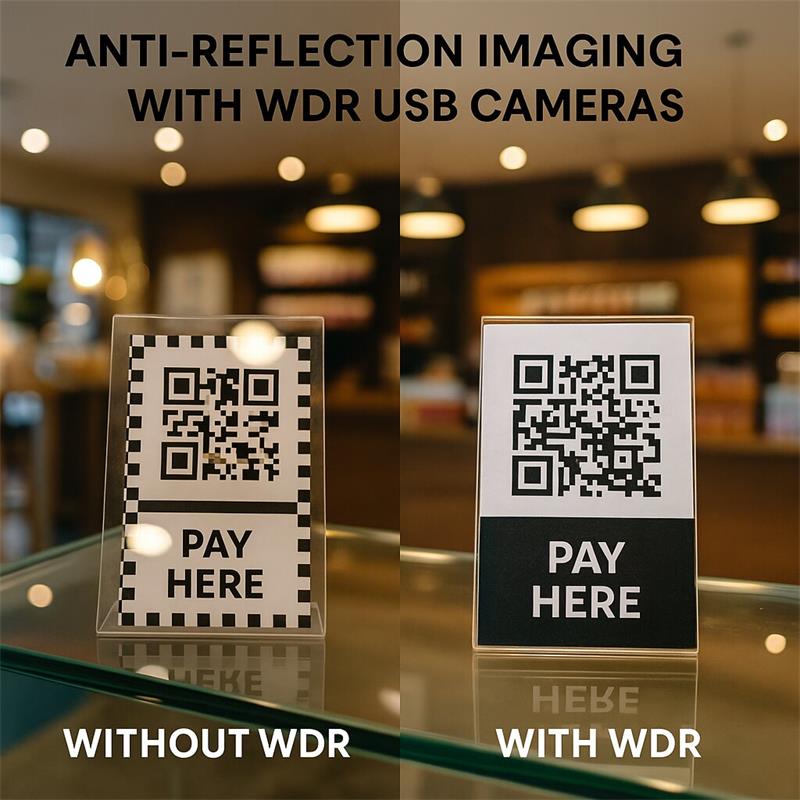
When you walk into a modern supermarket or airport kiosk, everything shines — polished glass, glossy metal, and overhead LED light. While these surfaces look clean and futuristic, they create a nightmare for embedded cameras.
Reflections from checkout counters or vending-machine glass often blind sensors, washing out barcodes or customer faces.
This is where WDR (Wide Dynamic Range) USB cameras transform the retail imaging landscape.
Engineers designing self-checkout terminals, AI vending systems, or ticketing kiosks face one recurring issue:
How do we capture consistent images when part of the frame is bright glare and the rest is in deep shadow?
In standard CMOS sensors (60–70 dB dynamic range), bright areas saturate instantly. When a customer stands near a glass counter or backlit window, the image either turns overexposed or the dark area becomes completely black.
For face recognition, barcode reading, or anti-fraud AI, this lighting instability causes frequent failure.
A WDR USB camera uses advanced exposure fusion and tone mapping to preserve details across both bright and dark zones.
The camera captures two (sometimes three) frames in rapid sequence:
An internal ISP merges the exposures pixel-by-pixel. It reconstructs both highlights and shadows to form a balanced HDR image.
Finally, adaptive gamma curves and gain mapping smooth transitions, preventing “halo” artifacts and maintaining realistic color.
Result: even under harsh ceiling light or window glare, the image retains natural contrast, accurate color, and usable detail for AI analysis.
|
Feature |
Advantage for Engineers |
Business Impact |
|
WDR 120 dB+ Dynamic Range |
Handles glass reflections & bright entrances |
Fewer image rejections / higher AI accuracy |
|
Plug-and-Play USB (UVC) |
Works on Windows, Linux, or Jetson |
Faster integration, no drivers needed |
|
Compact 15×15 mm Design |
Fits into tight kiosk or vending bezels |
Enables sleeker industrial design |
|
Industrial Reliability |
–20 ~ 70 °C, 24/7 stable operation |
Lower field maintenance cost |
|
Low-Light Performance (0.001 Lux) |
Works in night or dim corridors |
24-hour use without extra lighting |
A major German self-checkout manufacturer faced repeated barcode reading failures during daytime. Sunlight reflecting off polished steel and glass covers produced strong glare spots.
After replacing its generic camera with a 2MP WDR Micro USB module (UC-501-WDR):
The company now uses WDR modules as its default choice for all premium kiosk and SCO models in 2025.

|
Segment |
Example Use |
Result |
|
Self-Checkout Terminals |
Face ID, barcode recognition |
Stable imaging under mixed light |
|
Vending & Smart Cabinets |
Product verification behind glass |
No reflection interference |
|
Ticketing / Payment Kiosks |
Customer interaction at windows |
Clear faces even under sunlight |
|
Loss-Prevention Systems |
Behavior & queue monitoring |
Consistent frames for AI models |
2025 marks a shift from simple cameras to embedded vision systems.
With the rise of AI checkout, edge computing, and smart vending, cameras are no longer optional—they are the core of the user experience.
Choosing a camera that handles extreme lighting ensures stable data input for AI, fewer customer complaints, and longer hardware lifespans.
Reflections, glare, and lighting imbalance are unavoidable in modern retail environments — but they don’t have to defeat your vision system.
With a WDR Micro USB camera module, designers can achieve stable imaging across glass, steel, and mixed illumination conditions in any kiosk or checkout device.
Explore the UC-501 Series WDR USB Camera from Shenzhen Novel Electronics Limited at
www.okgoobuy.com/wdr-usb-camera-module-robotics-kiosks.html
Relative Articles links
1, What is a WDR USB Camera & How Does True WDR Work?
2, Why WDR USB Cameras Beat Normal Cameras in Industry
3, WDR Miniature USB Camera for Robotics, Kiosks & Vending & IOT UC-501-WDR
4, UC-501-WDR True WDR USB Cameras: Conquer Lighting Challenges